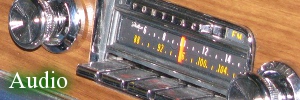















Satellite Radio Increasingly Popular With US Drivers |
|---|

|
John Birchard
January 31, 2004
 Listen to Satellite Radio Increasingly Popular With US Drivers - RealPlayer - 367KB - 2:58
Listen to Satellite Radio Increasingly Popular With US Drivers - RealPlayer - 367KB - 2:58
Two companies are betting Americans are willing to pay to listen to the radio, with the arrival of satellite radio in the cars and trucks on American roads.
Since the early 1930s, radio has accompanied Americans on the road. But both AM and FM radio broadcasting bands have their shortcomings: weak signals, interference and static, not to mention many, many commercials.
Now, however, the same satellite technology that makes possible global navigation and telephone communication is the basis for a new development in radio.
The two companies competing for listeners in this new field are XM Satellite Radio and Sirius Satellite Radio. We asked Chance Patterson, an executive with XM, how satellite radio works.
"We have our broadcast headquarters in Washington, D.C. And from our headquarters here, we send 120 channels of programming up to our two satellites, called Rock and Roll," he explained. And those satellites send down the programming information nationwide, across the US."
XM began its service in November of 2001, Sirius a few months later from New York City. A spokesman for Sirius, Ron Rodriguez, says one major advantage for listeners to satellite radio is choice.
"The fact that you can get a hundred channels and the vast majority of those channels are the types of programming that you can't get on terrestrial or traditional radio," he said.
XM's Chance Patterson cites another satellite advantage. "You also have a nationwide 'reach,'" he said. "You no longer have to worry about losing the signal when you drive away from your hometown. The signal reaches from Long Island (New York) to Long Beach (California) and everywhere in between."
Both companies point to commercial-free broadcasts as another attractive feature.
Customers pay around $120 for the receivers and $10 a month for the program service.
Auto manufacturers have taken a strong interest in satellite radio, both as an investment and an added accessory for their products. Ron Rodriguez lists the brands featuring Sirius.
"The manufacturers that are aligned with Sirius are Ford and Mazda and Volvo and so on," he said. "We also have BMW and we also have Daimler Chrysler and all of their associated brands. And those three manufacturers, by the way, represent about 40 plus percent of the car market."
XM, too, has an impressive line-up of carmakers. "General Motors, which, of course, builds GMC, Chevrolet, Cadillac, Pontiac, Buick, Hummer and Saab vehicles. All have XM available," said Chance Patterson. "And they are our largest shareholder. Our second-largest shareholder is American Honda."
XM can also be purchased in a new Toyota, Nissan and Audi. Both XM and Sirius radios can be purchased separate from a vehicle and some models are available for home use.
In our next report, we'll look at the prospects for the future of satellite radio.
